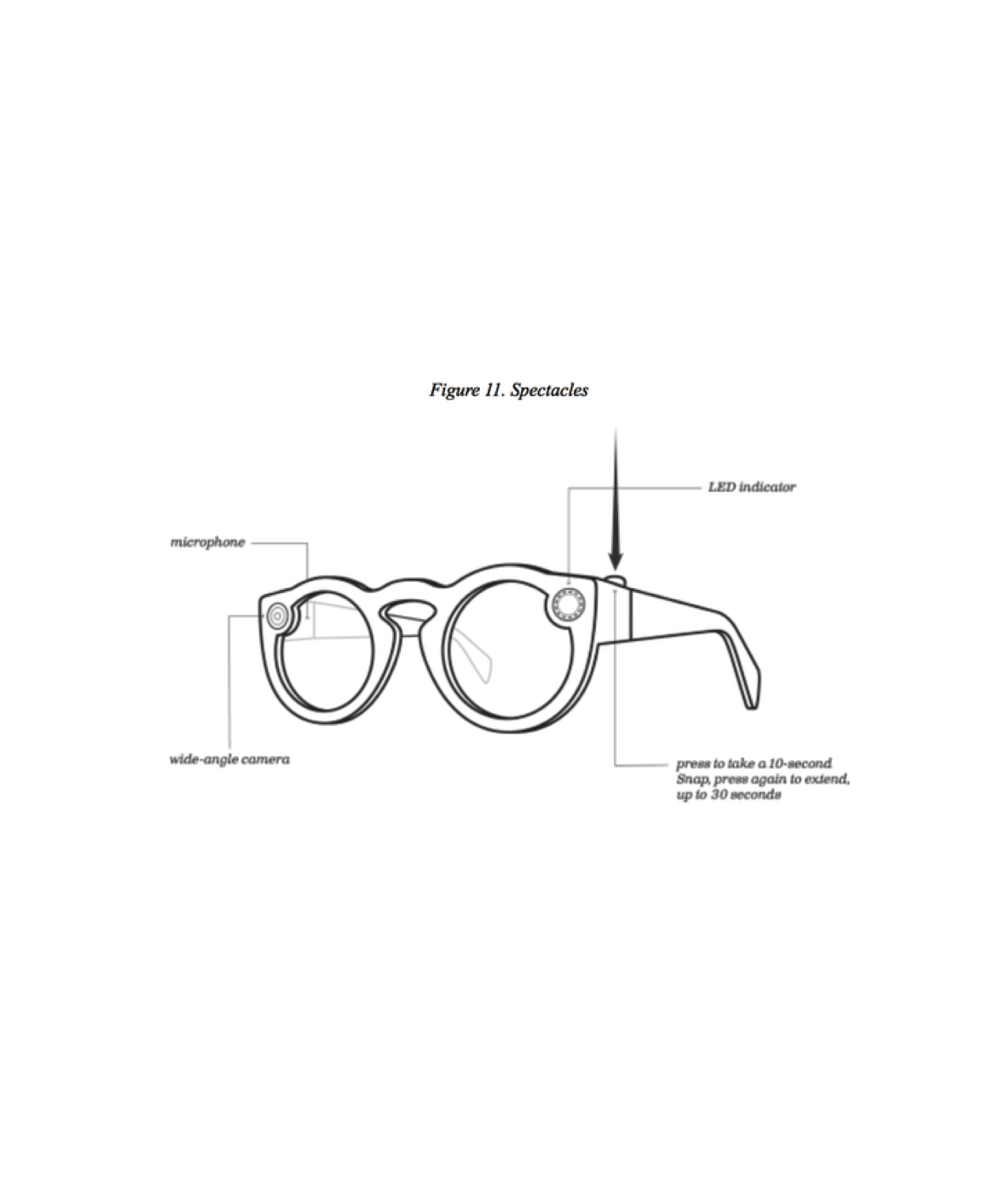Read in: [est_time]
If Snap widens the availability of its Spectacles, does it run the risk of destroying the niche cool appeal of the product and losing buyer interest?
Snap has called itself a camera company. Indeed this will turn out to be translated to be both a physical and virtual camera and lens system along with augmented reality both visual and audio devices and services. Clearly Spectacles have helped increase average revenue per user [1]:
Snap has filed for an IPO [1] and has mentioned risks:
Risk Factors Summary
Our business is subject to numerous risks and uncertainties, including those highlighted in “Risk Factors” immediately following this prospectus summary. These risks include:
• Our ecosystem of users, advertisers, and partners depends on the engagement of our user base. We anticipate that the growth rate of our user base will decline over time. If we fail to retain current users or add new users, or if our users engage less with Snapchat, our business would be seriously harmed.
• Snapchat depends on effectively operating with mobile operating systems, hardware, networks, regulations, and standards that we do not control. Changes in our products or to those operating systems, hardware, networks, regulations, or standards may seriously harm our user growth, retention, and engagement.
• We rely on Google Cloud for the vast majority of our computing, storage, bandwidth, and other services. Any disruption of or interference with our use of the Google Cloud operation would negatively affect our operations and seriously harm our business.
• We generate substantially all our revenue from advertising. The failure to attract new advertisers, the loss of advertisers, or a reduction in how much they spend, could seriously harm our business.
• Our two co-founders have control over all stockholder decisions because they control a substantial majority of our voting stock. The Class A common stock issued in this offering will not dilute our co-founders’ voting control because the Class A common stock has no voting rights.
• If we do not develop successful new products or improve existing ones, our business will suffer. We also invest in new lines of business that could fail to attract or retain users or generate revenue.
• Our business is highly competitive. We face significant competition that we anticipate will continue to intensify. If we are not able to maintain or improve our market share, our business could suffer.
• We have incurred operating losses in the past, expect to incur operating losses in the future, and may never achieve or maintain profitability.
• The loss of one or more of our key personnel, or our failure to attract and retain other highly qualified personnel in the future, could seriously harm our business.
• We have a short operating history and a new business model, which makes it difficult to evaluate our prospects and future financial results and increases the risk that we will not be successful.
• If our security is compromised or if our platform is subjected to attacks that frustrate or thwart our users’ ability to access our products and services, our users, advertisers, and partners may cut back on or stop using our products and services altogether, which could seriously harm our business.
• Our user metrics and other estimates are subject to inherent challenges in measurement, and real or perceived inaccuracies in those metrics may seriously harm and negatively affect our reputation and our business.
• We are not aware of any other company that has completed an initial public offering of non-voting stock on a U.S. stock exchange. We therefore cannot predict the impact our capital structure and the concentrated control by our founders may have on our stock price or our business.
…
If we do not develop successful new products or improve existing ones, our business will suffer. We also invest in new lines of business that could fail to attract or retain users or generate revenue.
Our ability to engage, retain, and increase our user base and to increase our revenue will depend heavily on our ability to successfully create new products, both independently and together with third parties. We may introduce significant changes to our existing products or develop and introduce new and unproven products, such as Spectacles or other technologies with which we have little or no prior development or operating experience. If new or enhanced products fail to engage our users, advertisers, or partners, we may fail to attract or retain users or to generate sufficient revenue, operating margin, or other value to justify our investments, any of which may seriously harm our business. For example, in mid-2016, we launched several products and released multiple updates, which resulted in a number of technical issues that diminished the performance of our application. We believe these performance issues resulted in a reduction in growth of Daily Active Users in the latter part of the quarter ended September 30, 2016. We may encounter other issues in the future that could impact our user engagement.
Because our products created new ways of communicating, they have often required users to learn new behaviors to use our products. These new behaviors, such as swiping and tapping in the Snapchat application, are not always intuitive to users. This can create a lag in adoption of new products and new user additions related to new products. To date, this has not hindered our user growth or engagement, but that may be the result of a large portion of our user base being in a younger demographic and more willing to invest the time to learn to use our products most effectively. To the extent that future users, including those in older demographics, are less willing to invest the time to learn to use our products, and if we are unable to make our products easier to learn to use, our user growth or engagement could be affected, and our business could be harmed. We may develop new products that increase user engagement and costs without increasing revenue. For example, we introduced Memories, our cloud storage service for Snaps, which increases our storage costs.
In addition, we have invested and expect to continue to invest in new lines of business, new products, and other initiatives to generate revenue. The launch of Spectacles, which has not generated significant revenue for us, is a good example. There is no guarantee that investing in new lines of business, new products, and other initiatives will succeed. If we do not successfully develop new approaches to monetization, we may not be able to maintain or grow our revenue as anticipated or recover any associated development costs, and our business could be seriously harmed.
~—~
I presented the case that the constrained supply of Spectacles added to a hype cycle. One can equate the release of Spectacles and the hype generated to the basic three-act structure [3] that divides a classic story into three distinct parts that weaves a familiar Quest theme:
- The Setup- The Pre Release hype
- The Confrontation-The constrained supply and the scavenger hunt
- The Solution-Wider release and adoption
This is a basic template that many professional writers use to build a story. It is also the template that Steve Jobs used, consciously or unconsciously to build Apple products and the demand around them. This was part of Steve’s “Reality distortion effect”. He used it constantly during his keynotes, in fact the words hype and Steve Jobs were interchangeable in the early years of Apple. This is a metaphorical journey/quest of the protagonist who encounters a problem, experiences conflict because of the problem, and then resolves that conflict at the end. The protagonist is the user, a bit of a reluctant hero and they are positioned so that they are part of a story—an adventure. They are guided through the three-act structure, especially through the Confrontation to Climax.
This story narrative has been used as far back as the earliest mythological allegories. Many of the elements of Spectacles and the way it is marketed send the protagonist and the company on a three act quest.
Thus Spectacles are:
- Solving a real problem of in-the-moment recording
- Perfectly priced to be accessible to the primary cohort
- Made to meet or exceed quality expectations
- Signals a social connection by wearing them, like the iPod headphone cables
- Constrained supply allows tastemakers to highly influence others
- Connects software to hardware in a perfect way
- Unorthodox press announcements creates more interest
- Theatrical buying experience, the unique vending machine
- Gamified scavenger hunt buying with countdown timers
- Apple-like lines of anticipation from primary users
The Final Act
As of early 2017, Snap has not only met the height level but it exceeded the hype level. Is clear the company will continue on creating more hardware products and more advanced versions of spectacles. Some of these products will be augmented reality with voice first interactions. If the company can continue to build heightened expectations and there is strong evidence they can, there is little doubt that the hype they have created will go down in history one of the most successful product launches.
The fundamental lesson here is; the release of Snap Spectacles will be the textbook example of how hype, if done correctly, is one of the most powerful forces in business.
Maintaining Demand
Snap will likely release and array of hardware devices and additions. It seems certain that the new releases, at least for a notable period of time where they will be held in constrained supply.
I think it is also likely that older versions, like the original spectacles, if they were successful, will become more widely available. There is little doubt that Snap will uses engaging and creative ways to extend availability, perhaps not exclusively using the SnapBot vending system and experiment with surprising new methods. New products can continue to be released under constrained supply and a scavenger hunt method while simultaneously making earlier versions or older devices more widely available.
Thus there is no doubt that the hype and exclusivity of Spectacles greatly influenced a mania. Clearly if Spectacles were easily available add any Walmart, they would still attract sales with the primary cohort of snapchat users because it does offer a high value, but the there would be a diminished perceived value.
If Snap continues to innovate and improve they can achieve, just like Apple has proven since the release of the original iPod, it is very possible to continue to expand the market availability of a product while still maintaining an air of exclusivity and uniqueness. Spoke to this idea more in a prior posting [3].
In the end it is the actual product and how it uniquely interacts with snapchat and other systems they create that will ultimately define the future success of hype and constrained supply at use by Snap. Thus far the company has created a historic high watermark that they themselves will have to out do.
I think they will supersede in the future anything they have done in the past.
[1] S-1 [2] Brian Roemmele’s answer to What are the marketing lessons than can be learned from the hype that surrounded the launch of Snap’s Spectacles? [3] Brian Roemmele’s answer to What are Snap, Inc. Spectacles and why are they important?
~—~
~—~
Subscribe ($99) or donate by Bitcoin.
Copy address: bc1q9dsdl4auaj80sduaex3vha880cxjzgavwut5l2
Send your receipt to Love@ReadMultiplex.com to confirm subscription.


IMPORTANT: Any reproduction, copying, or redistribution, in whole or in part, is prohibited without written permission from the publisher. Information contained herein is obtained from sources believed to be reliable, but its accuracy cannot be guaranteed. We are not financial advisors, nor do we give personalized financial advice. The opinions expressed herein are those of the publisher and are subject to change without notice. It may become outdated, and there is no obligation to update any such information. Recommendations should be made only after consulting with your advisor and only after reviewing the prospectus or financial statements of any company in question. You shouldn’t make any decision based solely on what you read here. Postings here are intended for informational purposes only. The information provided here is not intended to be a substitute for professional medical advice, diagnosis, or treatment. Always seek the advice of your physician or other qualified healthcare provider with any questions you may have regarding a medical condition. Information here does not endorse any specific tests, products, procedures, opinions, or other information that may be mentioned on this site. Reliance on any information provided, employees, others appearing on this site at the invitation of this site, or other visitors to this site is solely at your own risk.
Copyright Notice:
All content on this website, including text, images, graphics, and other media, is the property of Read Multiplex or its respective owners and is protected by international copyright laws. We make every effort to ensure that all content used on this website is either original or used with proper permission and attribution when available.
However, if you believe that any content on this website infringes upon your copyright, please contact us immediately using our 'Reach Out' link in the menu. We will promptly remove any infringing material upon verification of your claim. Please note that we are not responsible for any copyright infringement that may occur as a result of user-generated content or third-party links on this website. Thank you for respecting our intellectual property rights.

